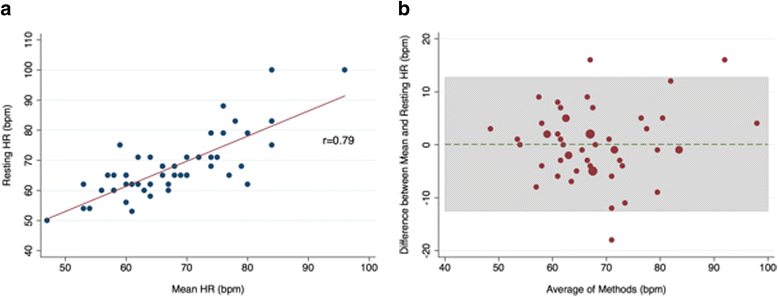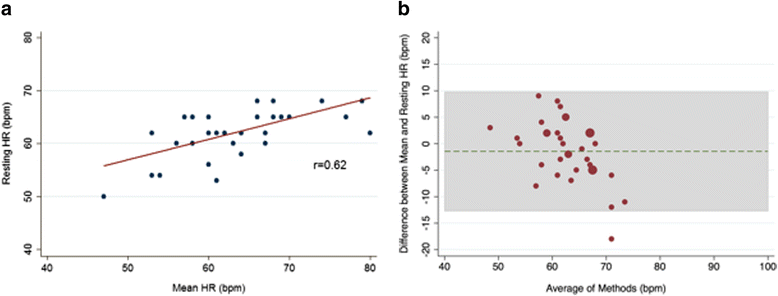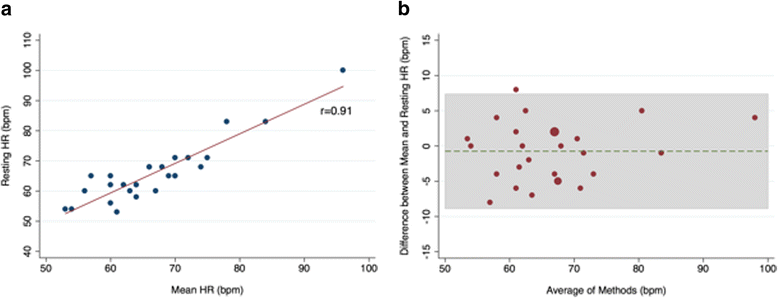Heart rate in patients with reduced ejection fraction: relationship between single time point measurement and mean heart rate on prolonged implantable cardioverter defibrillator monitoring
- PMID: 29385998
- PMCID: PMC5793357
- DOI: 10.1186/s12872-018-0751-2
Heart rate in patients with reduced ejection fraction: relationship between single time point measurement and mean heart rate on prolonged implantable cardioverter defibrillator monitoring
Abstract
Background: Heart rate (HR) is a prognostic marker that is increasingly used as a therapeutic target in patients with cardiovascular disease. The association between resting and mean HR remains unclear. We therefore set out to determine the relationship between resting HR on the electrocardiogram (ECG) obtained at a single time point, and mean HR on implantable cardioverter defibrillator (ICD) interrogation amongst patients with a reduced left ventricular ejection fraction (LVEF).
Methods: Prospective ICD data were obtained from 54 patients with LVEF < 40%. Mean HR determined using the ICD HR histograms was compared with resting HR measured on the ECG performed in the clinic.
Results: Average resting and ICD mean HRs were 67.9 ± 10.1 and 67.8 ± 9.6 bpm respectively. There was good correlation in the overall cohort (r = 0.79), in those with resting ECG HRs ≤ 70 bpm (r = 0.62), and amongst the 27 patients on intermediate-to-high dose beta-blockers (r = 0.91). However, Bland-Altman analysis demonstrated wide limits of agreement in the overall cohort (- 12.5, 12.7 bpm), at resting HRs ≤ 70 bpm (- 12.7, 9.8 bpm), and on intermediate-to-high dose beta-blockers (- 8.9, 7.4 bpm). Moreover, resting HR did not predict the 10-bpm interval where the most time was spent.
Conclusions: While resting HR correlated with mean HR in patients with reduced LVEF, and in important subgroups, the limits of agreement were unacceptably wide raising concern over the use of single time point resting HR as a therapeutic target.
Keywords: Beta-blockers; Mean heart rate; Resting heart rate.
Conflict of interest statement
Ethics approval and consent to participate
The study was approved by the
Consent for publication
Not applicable.
Competing interests
The authors declare that they have no competing interests.
Publisher’s Note
Springer Nature remains neutral with regard to jurisdictional claims in published maps and institutional affiliations.
Figures



Similar articles
-
Determinants of patient survival rate after implantation of a cardioverter-defibrillator without resynchronisation capability.Kardiol Pol. 2012;70(11):1099-110. Kardiol Pol. 2012. PMID: 23180517
-
Left ventricular ejection fraction normalization in cardiac resynchronization therapy and risk of ventricular arrhythmias and clinical outcomes: results from the Multicenter Automatic Defibrillator Implantation Trial With Cardiac Resynchronization Therapy (MADIT-CRT) trial.Circulation. 2014 Dec 23;130(25):2278-86. doi: 10.1161/CIRCULATIONAHA.114.011283. Epub 2014 Oct 9. Circulation. 2014. PMID: 25301831 Clinical Trial.
-
Heart rate variability density analysis (Dyx) for identification of appropriate implantable cardioverter defibrillator recipients among elderly patients with acute myocardial infarction and left ventricular systolic dysfunction.Europace. 2015 Dec;17(12):1848-54. doi: 10.1093/europace/euu394. Epub 2015 Mar 8. Europace. 2015. PMID: 25755288
-
Effect of left ventricular ejection fraction and QRS duration on the survival benefit of implantable cardioverter-defibrillators: meta-analysis of primary prevention trials.Heart Rhythm. 2013 Feb;10(2):200-6. doi: 10.1016/j.hrthm.2012.10.039. Epub 2012 Oct 27. Heart Rhythm. 2013. PMID: 23107652 Review.
-
The need to modify patient selection to improve the benefits of implantable cardioverter-defibrillator for primary prevention of sudden death in non-ischaemic dilated cardiomyopathy.Europace. 2013 Dec;15(12):1693-701. doi: 10.1093/europace/eut228. Epub 2013 Aug 14. Europace. 2013. PMID: 23946316 Review.
References
Publication types
MeSH terms
Grants and funding
LinkOut - more resources
Full Text Sources
Other Literature Sources
Medical

